Technical Analysis (CHP)
Introduction
This section of the Combined Heat and Power (CHP) feasibility study provides the technical analysis. The goal of this section is to deliver a clear understanding of CHP from a technical point of view. Another goal is to offer Lafayette College an understanding of what they will need in order to capitalize from CHP. This section will begin by providing a brief introduction of CHP, the benefits, and why CHP is needed. The next part of the technical analysis will describe the current central heating and distribution system on the Lafayette College campus. Here, prior studies of potential CHP proposal for Lafayette College will also be reviewed. The analysis will then describe the components of a CHP system, including a description of prime movers, generators, and the distribution grid configuration. Finally, this section will provide suggestions on the components Lafayette College should utilize in designing their CHP system.
Description
Combined Heat and Power (CHP), also known as cogeneration, refers to a system of proven technologies that operate together for the current generation of electricity and useful heat, as seen in Figure 1 (Pew Center on Global Climate Change [Pew], 2011).
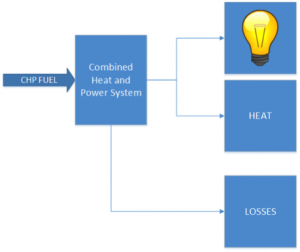
According to the Pew Center on Global Climate Change, CHP uses commercially available technologies that decrease total fuel consumption and decrease related greenhouse gas emissions (GHG). Additionally, CHP many offer numerous benefits including:
- Reducing air pollutants
- Providing on-site electricity generation that is resilient in the face of grid outages
- Using far less fuel than traditional heat and power production
- Being powered by a variety of fuels, including natural gas, coal, oil and alternative fuels; this feature of CHP makes the system less vulnerable to fuel availability and volatile commodity prices
- Achieving 80% efficiency during the Combined Heat and Power process
The past few years have been the hottest on record and the effects of climate change are now more visible than ever. Greenhouse gasses, emitted through widespread massive use of fossil fuels, are directly linked to this disturbance in our climate. Therefore, there is a need for energy systems that provide increased efficiency while reducing GHG emissions and costs, and improving reliability. Also, an increased need for the utilization of CHP exists in the large-scale industrial and/or institutional sectors. These sectors are responsible for a majority of the total energy consumption in the US. These sectors are also responsible for a majority of the US total GHG emissions. The industrial sector’s direct GHG emissions account for 20% of the US total emission (Pew, 2011). Therefore, there is an obvious need for CHP in order to reduce GHG emissions, increase efficiency, and improve reliability. Combined Heat and Power is appropriate in situations where a facility has a continuous demand for heating or cooling, as well as a demand for electrical power. Therefore, CHP is an ideal investment for a college campus.
Lafayette College Current Infrastructure
The current central heating system and distribution at Lafayette College consists of 5 boilers located in the heating plant (Paulien & Associates, Inc. [Paulien], 2008 p. 108). The boilers’ burners are currently capable of firing either on natural gas, or on #2, #4 or #6 fuel oil. The local utility company provides Lafayette College with interruptible natural gas service (Paulien, 2008, p.110).
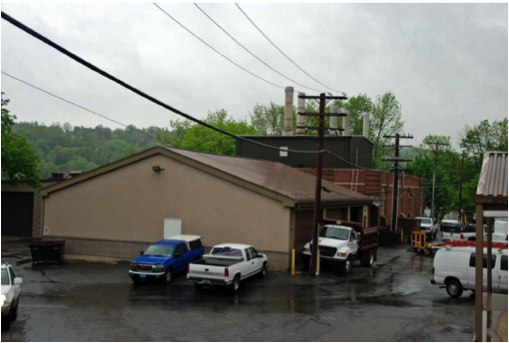
The existing steam loads for the campus buildings are calculated based on unitary load factors and building gross area (Paulien, 2008, p.109). To satisfy peak loads, Lafayette College only needs 2 boilers (Paulien, 2008, p.110). The boilers generate steam for distribution to campus buildings via an underground piping distribution system. The steam is utilized for building heating and for domestic hot water generation (Paulien, 2008, p.111).
Bruce Ferretti, the Director of Facilities Operations, has expressed great desire and interest in CHP for Lafayette. Bruce Ferretti informed us that CHP has been discussed and proposed a few times in the recent past. Lafayette College’s administration and Board of Trustees has provided support for CHP projects due to its low investment cost, ability to have a quick payback period, and ability to make Lafayette College more sustainable. The first time CHP had been discussed was in response to a donor’s suggestion; the CHP system suggested was a bio-waste system. This system could create electricity and heat from bio-waste; however, this system was not pursued further because it was deemed economically inefficient and technically difficult (B. Ferretti, personal communication, October 13, 2016).
CHP was seriously discussed again in response to Superstorm Sandy when Lafayette experienced a blackout for an extended time. Lafayette has proposed several different CHP designs; however, the college has failed to institute them due to the fuel market instability (B. Ferretti, personal communication, October 13, 2016). The fuel market will be discussed further in the Economic Analysis section of this feasibility study.
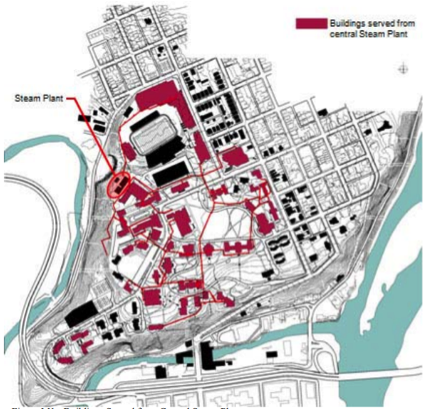
Combined Heat and Power System Design
Combined Heat and Power system has two types of cycles: the “topping cycle” and the “bottoming cycle”. The “topping cycle” is the most common; during this cycle the fuel is first used to generate electricity, and then a portion of the waste from the power generation is used to provide useful thermal energy (Pew, 2011). A “bottoming cycle” CHP system first produces useful heat for a manufacturing process via fuel combustion or another heat-generating chemical reaction and then recovers some portion of the exhaust heat to generate electricity (Pew, 2011). CHP systems are designed to meet the needs of each individual customer. System designs are modified based on location, size, and energy requirements (Pew, 2011).
A typical CHP system functions in the following way, the prime movers consume fuel (coal, natural gas, or biomass) via combustion to power a generator to produce electricity, or to drive rotating equipment (Pew, 2011). The prime movers also produce thermal energy that can be captured and used for other on-site processes (Pew, 2011). There are four primary, commercially available prime movers:
- Gas Turbines
- Steam Turbines/Reciprocating Engines
- Micro-turbines
- Fuel Cells
Gas turbines operate where natural gas is combusted and used to turn turbine blades and spin an electrical generator. The system then uses a heat recovery system to capture the heat from the gas turbine’s exhaust stream. This exhaust heat can be used for generating steam for industrial processes or generating chilled water through absorption. Gas turbines have capacities between 500 kilowatts and 250 megawatts. The benefits of these systems are that gas turbines are high-grade heat applications and are highly reliable (Pew, 2011). The gas turbine CHP system is illustrated in Figure 4.
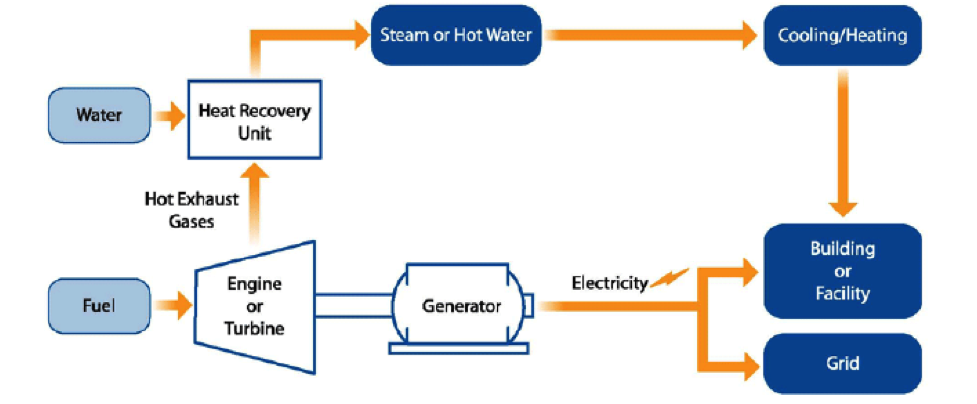
Steam turbines work by combusting fuel in a boiler to heat water and create high-pressure steam, which turns a turbine to generate electricity. The low-pressure steam that subsequently exits the steam turbine can then be used to provide useful thermal energy. Steam turbines have capacities between 50 kilowatts and 250 megawatts. The benefits of these systems are that they can run from a variety of fuels, are highly reliable, and can meet multiple heat grade requirements. This can be a major benefit for steam turbines because, as seen later in the economic analysis section, fuel prices are a major determining factor for Lafayette not installing CHP. Additionally, reciprocating internal combustion engines are used in combination with steam turbines. Reciprocating engines use one or more reciprocating pistons to convert pressure into a rotating motion. Multiple reciprocating engines can be used to increase system capacity, enhance overall reliability and efficiency (Pew, 2011). The steam CHP system is illustrated in Figure 5.
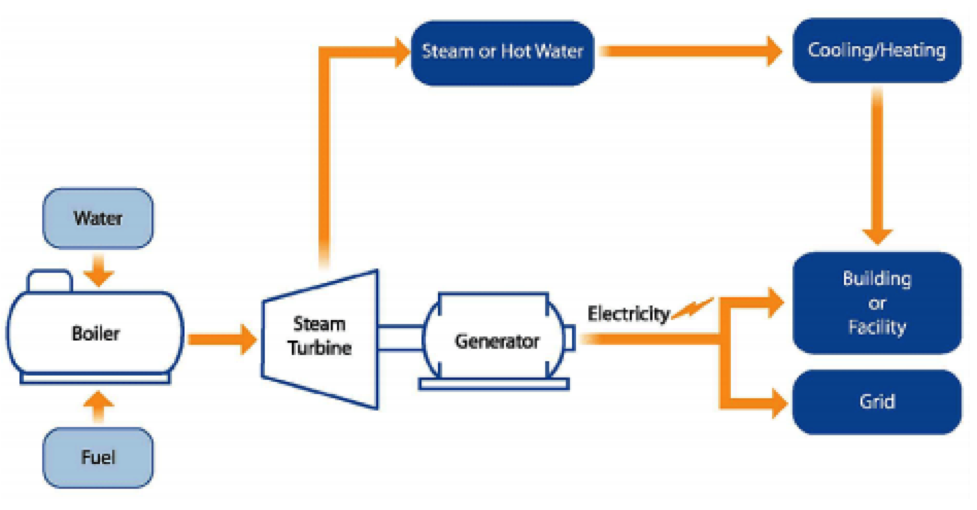
Micro-turbines and fuel cells will not be discussed in this technical analysis because they do not have the power output to support the energy required by Lafayette College. For more information on micro-turbines and fuel cells please refer to Cogeneration/Combined Heat and Power (CHP) Climate Techbook by Pew Center on Global Climate Change.
The next step in the technical analysis of the feasibility study of CHP for Lafayette College is analyzing the types of generators. There are two types of generators utilized in CHP systems: synchronous generators and induction generators.
Synchronous generators are self-excited generators, meaning they do not need the grid to provide the source of excitation. Therefore, the system has the potential to continue to produce power through grid brownouts and blackouts. CHP owners prefer synchronous generators because of this unique characteristic. Synchronous generators are more complex and costly in order to safely connect to the grid because the interconnection must ensure when the grid is de-energized the CHP system does not export power back to the grid. However, a benefit of synchronous generators is they provide greater electrical power reliability to customers. In addition, these types of generators have an overall positive effect on facilities power factors, which means the total power delivered by a source is used for real work (Midwest CHP Application Center [Midwest], 2007, p. 22).
Induction generators will not be discussed in this technical analysis because they do not have the necessary characteristics required by Lafayette College. For more information on induction generators please refer to Combined Heat & Power (CHP) Resource Guide for Hospital Applications.
The final design component of the CHP system is the common point of interconnection to the local electric utility distribution grid. The distribution grid is a low voltage system, which ties the site to the larger, higher voltage transmission system. The tie between the transmission and distribution grids occurs at the utility substations. There are two types of distribution systems applicable to CHP systems: radial systems, and looped and network systems (Midwest, 2007, p. 25).
The radial system is the most common type of distribution grid system for CHP. It has a single path for power flow to all customers on a single radial feed and the system is made up of multiple radial lines. On the occasion of a fault in a radial feed, only the customers on that feed will be affected. The utility can isolate the fault and keep some portion of the radial feed operating during repairs by using sectionalizing switches. Radial systems are the easiest and least costly preferred system to interconnect with a CHP system (Midwest, 2007, p. 25).
Loop and network systems, unlike radial systems, provide multiple paths for power flow to all customers on the system. On the occasion of a fault in a loop and network system, the utility has the ability to keep more customers online compared to the radial system while isolating and repairing the fault. Loop and network systems are mainly found in large metropolitan areas due to their complexity. Loop and network systems are also more costly and difficult to interconnect to the CHP system (Midwest, 2007, p. 25).
Conclusion
This technical analysis, based on research and interviews conducted with Lafayette personal, makes the following suggestions for the prime mover, the generator, and the distribution grid configuration included in the college CHP system.
The current central heating system and distribution at Lafayette College exists as a steam turbine system; therefore, a change to any new system would not make economic sense. Also, Lafayette College has expressed a desire to have reciprocating engines in order to enhance reliability and efficiency of the system. Reciprocating engines are used in combination with steam turbines; therefore, Lafayette College should maintain their existing steam turbine system and purchase reciprocating engines.
Even though Lafayette College already has the infrastructure to support a steam turbine CHP system on their campus, it would be important to conduct a technical analysis of energy use on campus to ensure that a steam turbine CHP system is the most efficient. This technical analysis of energy use on campus will utilize the thermal to electric (T/P) ratio that can be estimated using Lafayette College’s utility bills (Midwest, 2007, p. 21). In order to calculate the T/P ratio for Lafayette College the analysis pictured in Figure 6 needs to be completed to determine the appropriate prime mover technology. The results of Figure 6 would need to be compared to Figure 7.
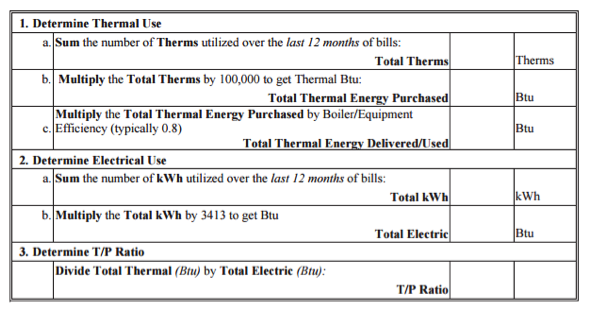
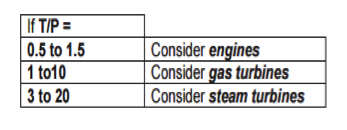
The technical analysis of energy use on campus was one of the goals of the feasibility assessment; however, it could not be completed, as the information required could not be obtained. Regardless, the following suggestion of maintaining the existing steam turbine system as the prime mover and purchase/install reciprocating engines is the best option available based on the research to date.
Through interviews and conversations with faculty, administrators, and professors, it has become apparent that Lafayette College is interested in synchronous generators. Lafayette’s faculty, administrators and professors have all expressed a desire to be able to function while the grid is down. This desire has come after experiencing the consequences of long blackouts due to weather conditions like Superstorm Sandy and more recently the power outage experienced on Halloween weekend this past year. Lafayette College would like to avoid having to cancel class, close dining halls, waste food, and send students home due to the unsafe conditions of a campus without power. Therefore, to satisfy these desires Lafayette College should install a synchronous generator.
Lafayette College is already successfully connected to the distribution grid, as stated from interviews conducted with faculty. However, we are unsure about which type of distribution grid configuration Lafayette College is interconnected with due to the unavailability of documentation and information. However, this technical analysis suggests that Lafayette College utilizes a radial system, which is based on the research done on the two types of distribution systems applicable to CHP systems. Lafayette College is not located in a metropolitan area; therefore, it does not need the complexity associated with the loop and network system. Lafayette College’s CHP system would run efficiently and be less costly by utilizing a radial system for its interconnection to the local electric utility distribution grid.
As far as the technical application goes, Lafayette College is very close to having an operational Combined Heat and Power system. There are very few technical challenges/decisions to overcome. The next section of the feasibility assessment will provide an analysis of Combined Heat and Power through the context of a Policy Analysis.
